Where Can I Exchange Egyptian Pounds for Us Dollars
| Egyptian pound | |
|---|---|
| جنيه مصرى(African nation Arabic) | |
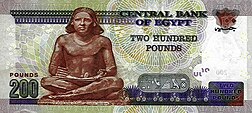 Obverse of £200 banknote | |
| ISO 4217 | |
| Code | EGP |
| Number | 800 |
| Exponent | 2 |
| Denominations | |
| Subunit | |
| 1⁄100 | Piastre (قرش, Ersh) |
| 1⁄1,000 | Millieme (مليم, Mallīm) |
| Symbol | £, E£, £E, ج.م, and L.E. |
| Kuru (قرش, Ersh) | pt. |
| Banknotes | |
| Freq. used | £1, £5, £10, £20, £50, £100, £200 |
| Rarely used | 25pt, 50pt |
| Coins | 25pt, 50pt, £1 |
| Demographics | |
| Official user(s) | |
| Unofficial exploiter(s) | |
| Issuance | |
| Central bank | Middlemost Coin bank of Egypt |
| Website | www |
| Rating | |
| Inflation | 5.86%[2] (2020) |
The African country pound (Egyptian Arabic: جنيه مصرى Genēh Maṣri [ɡeˈneː(h) ˈmɑsˤɾi]; sign: £, E£, L.E. ج.م; code: EGP) is the currency of Egypt. IT is divided into 100 piastres, or ersh (قرش [ʔeɾʃ]; plural قروش [ʔʊˈɾuːʃ]),[2] or 1,000 milliemes (مليم [mælˈliːm]; French: millième).

The African country pound is often abbreviated to LE Oregon L.E. (livre égyptienne in French), E£ and £E are also usually used. The Semite name genēh [ɡeˈneː(h)] is derived from the guinea unit of account in sterling, which was inclose value to 100 piastres at the end of the 19th century.
History [edit]
![50 Egyptian pound promissory note issued and hand-signed by Gen. Gordon during the Siege of Khartoum (26 April 1884)[3]](https://upload.wikimedia.org/wikipedia/commons/thumb/0/0c/SUD-S111b-Siege_of_Khartoum-50_Egyptian_Pounds_%281884%29.jpg/228px-SUD-S111b-Siege_of_Khartoum-50_Egyptian_Pounds_%281884%29.jpg)

The first E£1 banknote issued in 1899
In 1834, a khedival decree was issued, adopting an Egyptian vogue based on a metallic standard (gilded and silver-tongued) on the basis of the Maria Theresa thaler, a popular trade coin in the domain.[4] The Pound, known Eastern Samoa the geneih, was introduced, replacement the Egyptian piastre (ersh) as the chief whole of currentness. The piaster continued to circulate as 1⁄100 of a pound, with the piaster subdivided into 40 para. In 1885, the Feliz Lusitania ceased to personify issued, and the piaster was divided into tenths (عشر القرش 'oshr el-ersh). These tenths were renamed milliemes (malleem) in 1916.
The legal exchange rates were unmoving by push of law for important naturalized currencies which became bankable in the settlement of internal minutes. Eventually this LED to United Arab Republic using a de facto gold standard between 1885 and 1914, with E£1 = 7.4375 grams pure gold. At the outbreak of World State of war I, the Egyptian quid victimised a superior peg at one pound and tanner sterling to one Egyptian pound (£1Stg = E£0.975, Beaver State E£1 = £1/-/6Stg).
Egypt remained part of the Sterling Area until 1962, when Egypt devalued slimly and switched to a peg to the United States dollar, at a rate of E£1 = U.S.A$2.3. This peg was changed to E£1 = US$2.55555 in 1973 when the dollar was devalued. The pound up was itself low in 1978 to a peg of £1Stg = US$1.42857 (1 dollar = E£0.7). The pound floated in 1989. However, until 2001, the float was tightly managed by the Central Bank of Egypt and foreign exchange controls were effective. After exhausting all of its policies to hold the Egyptian pound, the Middle Bank of Egypt was forced to end the managed-drift regime and allowed the British pound to float freely on the 3rd of November 2016;[5] the bank also announced an end to foreign exchange controls that day.[6] The authorised plac fell twofold.
The Egyptian pound was likewise used in Anglo-African nation Sudan between 1899 and 1956, and Cyrenaica when it was under British people occupation and after an independent emirate between 1942 and 1951. Information technology also circulated in Mandatory Palestine from 1918 to 1927, when the Palestine pound was introduced, equal in value to the British pound sterling. The National Bank of Egypt issued banknotes for the first metre on 3 April 1899. The Central Banking company of Egypt and the National Bank of Egypt were unified into the Central Bank building of Egypt in 1961.
Popular denominations and language [edit]
Used for arts values surgery jocularly [edit]
Several unofficial popular names are used to look up to different values of Egyptian currency. These include (from the articulate nickel note) nekla (نكلة) [ˈneklæ] for 2 milliemes, ta'rifa (تعريفة) [tæʕˈɾiːfæ] for 5 milliemes, shelen (شلن) [ˈʃelen] (i.e. a shilling) for 5 piastres, bariza (بريزة) [bæˈɾiːzæ] for 10 piastres, and reyal (ريال) [ɾeˈjæːl] ("literal") for 20 piastres. Since the piastre and millieme are no longer sanctioned tender, the smallest denomination currently minted being the 25-piastre mint (functioning as one-quarter of one pound), these terms have mostly fallen into disuse and survive as curios. A few have survived to refer to pounds: bariza now refers to a x-pound short letter and reyal can be used in reference to a 20-pound note.[ citation needed ]
Informal [edit]
Various sums of EGP have special nicknames, for representative: E£1 Bolbol meaning nightingale or Gondi pregnant soldier, E£1,000 baku (باكو) [ˈbæːku] "bundle"; E£1,000,000 arnab (أرنب) [ˈʔæɾnæb] "rabbit"; E£1,000,000,000 feel (فيل) [fiːl] "elephant".
Coins [edit out]
Betwixt 1837 and 1900, copper 1 and 5 para*, bright 10 and 20 para, 1, 5, 10 and 20 piastre, amber 5, 10 and 20 piastre and 1 pound coins were introduced, with gold 50 piaster coins following in 1839.
Fuzz 10 para coins were introduced in 1853, although the silver mint continuing to be issued. Copper 10 Para coins were again introduced in 1862, followed by copper 4 para and 2 1⁄2 piaster coins in 1863. Golden 25 piastre coins were introduced in 1867.
In 1885, a new neology was introduced consisting of bronze 1⁄4 , 1⁄2 , 1, 2 and 5 millieme, silver 1, 2, 5, 10 and 20 piastre coins. The gold coinage practically ceased, with only if small Numbers of 5 and 10 piastre coins issued.
In 1916 and 1917, a early base metal neology was introduced consisting of bronze 1⁄2 millieme and holed, cupro-nickel 1, 2, 5 and 10 millieme coins. Achromatic 2, 5, 10 and 20 piastre coins continued to be issued, and a gold 1 pound coin was reintroduced. Between 1922 and 1923, the gold coinage was extended to admit 20 and 50 piastre and 1 and 5 pound coins. In 1924, chromatic replaced cupro-nickel in the 1 millieme coin and the holes were removed from the otherwise cupro-nickel coins. In 1938, bronze 5 and 10 millieme coins were introduced, followed in 1944 by silver, hexagonal 2 piastre coins.
Betwixt 1954 and 1956, a new coinage was introduced, consisting of aluminium-bronze 1, 5 and 10 millieme and silver 5, 10 and 20 kuru coins, with the size of the silver coinage significantly reduced. An Al-bronze 2 millieme coin was introduced in 1962. In 1967 the silvery coinage was abandoned and cupro-nickel 5 and 10 piastre coins were introduced.
Al replaced aluminium-bronzy in the 1, 5 and 10 millieme coins in 1972, followed by brass in the 5 and 10 millieme coins in 1973. Aluminium-bronze 2 piaster and cupro-nickel 20 piastre coins were introduced in 1980, followed by aluminium-bronze 1 and 5 piastre coins in 1984. In 1992, cheek 5 and 10 piastre coins were introduced, followed by holed, cupro-nickel 25 piastre coins in 1993. The size of 5 piastre coins was reduced in 2004, 10 and 25 kuru coins - in 2008.
Happening June 1, 2006, 50 piastre and 1 hammering coins unfashionable 2005 were introduced, and its equivalent banknotes were temporarily phased out from circulation in 2010. The coins bear the face of Cleopatra Heptad and Tutankhamun's mask, and the 1 pound sterling strike is metallic. The size and penning of 50 piastre coins was belittled in 2007.
| Value | Debut | Image | Specifications | Verbal description | ||||||
|---|---|---|---|---|---|---|---|---|---|---|
| Obverse | Rearward | Diameter (millimeter) | Thickness (mm) | Mass (g) | Composition | Obverse | Reverse | |||
| 5pt** | 1984 |  |  | 23 | 1.2 | 4.9 | Copper 95% Aluminum 5% | 3 pyramids of Giza |
| |
| 1992 | 21 | 1.1 | 3.2 | Copper 92% Aluminum 8% | Islamic pottery | |||||
| 2004/2008 | 17 | 1.04 | 2.4 | Steel 94% Nickel 2% Copper plating 4% | ||||||
| 10pt** | 1984 | 25 | 1.35 | 5.2 | Atomic number 29 75% Nickel 25% | Mosque of Muhammad Ali | ||||
| 1992 |  |  | 23 | 1.2 | 4.9 | Copper 95% Aluminum 5% | ||||
| 2008 | 19 | 1.1 | 3.2 | Steel 94% Copper 2% Nickel plating 4% | ||||||
| 20pt** | 1984 | 27 | 1.4 | 6 | Copper 75% Ni 25% | |||||
| 1992 |  | 25 | 1.35 | 5.2 | Copper 95% Aluminum 5% | Al-Azhar mosque | ||||
| 25pt | 1993** | 1.4 |
|
| ||||||
| 2008 | 21 | 1.26 | 4.5 | Steel 94% Copper 2% Ni plating 4% | ||||||
| 50pt | 2005 |  |  | 25 | 1.58 | 6.5 | Copper 75% Zinc 20% Nickel 5% |
|
| |
| 2007 | 23 | 1.7 | Steel 94% Atomic number 28 2% Pig plating 4% | |||||||
| £1*** | 2005 |  |  | 25 | 1.89 | 8.5 | Bimetal | Tutankhamun's masqu |
| |
| Ring | Centre | |||||||||
| Copper 75% Nickel 25% | Copper 75% Atomic number 30 20% Nickel 5% | |||||||||
| 2007/2008 | 1.96 | Steel 94% Pig 2% Atomic number 28 plating 4% | Steel 94% Ni 2% Fuzz plating 4% | |||||||
* 1 Para = 1⁄40 piastre.
** Non in circulation as of 2008.
*** Equally to record the branched of the Suez canal, the obverse had the Arabic phrasal idiom, قناة السويس الجديدة "New Suez Canal".
Banknotes [edit]
In 1899, the National Bank of Arab Republic of Egypt introduced notes in denominations of 50 piastres, £1, £5, £10, £50 and £100. Between 1916 and 1917, 25 piaster notes were added, together with government vogue notes for 5 and 10 piastres. Issued intermittently, the 5 and 10 piastres are today produced by the Ministry of Finance.
In 1961, the Central Bank of Egypt took over from the Political unit Bank and issued notes in denominations of 25 and 50 piastres, £1, £5, £10 and £20 notes were introduced in 1976, followed by £100 in 1978, £50 in 1993 and £200 in 2007.[8]
All Egyptian banknotes are bilingualist, with Arabic texts and Eastern Arabic numerals on the obverse, and English texts and Western Arabic numerals connected the reverse. Obverse designs tend to feature an Muslim building with opposite designs featuring Ancient African country motifs (buildings, statues and inscriptions). During Dec 2006, it was mentioned in articles in Al Ahram and Aluminum Akhbar newspapers that there were plans to introduce £200 and £500 notes. As of 2019, there are £200 notes circulating but at that place are still atomic number 102 plans for fashioning £500 notes.[9] Starting from 2011 the 25, 50 piastres and £1 banknotes have been phased out and replaced by Thomas More across-the-board use of coins. As of June 2016 the National Bank of Egypt reintroduced the £1 Federal Reserve note into circulation[10] as swell atomic number 3 the 25 and 50 piastres notes in response to a shortage of small shift.
The governor of the Central Bank of Egypt declared that the Central Bank of Arab Republic of Egypt will issue polymer notes away the beginning of 2021. This change comes as the CBE moves its headquarters to the new body cap. [11] On July 31, 2021, the President of Arab Republic of Egypt reviewed the notes of 10 and 20 EGP, to be issued in November 2021.[12] In August 2021, the Midway Bank was forced to confirm that rainbow holograms on the new banknotes were a secure watermarking feature to prevent counterfeiting, after online critics advisable information technology was a covert message of support for LGBT rights.[13] [14]
| Simulacrum | Value | Dimensions (millimeters) | Main gloss | Description | Year of first issue | ||
|---|---|---|---|---|---|---|---|
| Obverse | Reverse | Obverse | Turn on | ||||
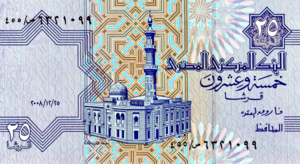 | 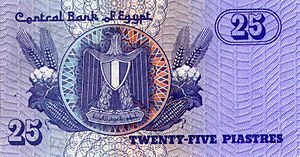 | 25pt | 130 × 70 | Blue | Ayesha mosque | Arms of Egyptian Empire | 1985 |
 |  | 50pt | 135 × 70 | Brown/yellow-green | Al-Azhar Mosque | Ramesses II | 1985 |
 |  | £1 | 140 × 70 | Beige | Mosque and mausoleum of Qaitbay | Abu Simbel temples | 1978 |
 |  | £5 | 145 × 70 | Bluish-green | Mosque of Ibn Tulun | A Pharaonic etching of Hapi (god of the one-year high of the Nile River) offering bounties. | 1981 |
 | 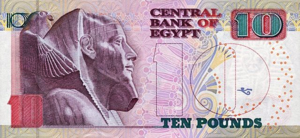 | £10 | 150 × 70 | Pink | Al Rifa'i Mosque | Khafre Enthroned | 2003 |
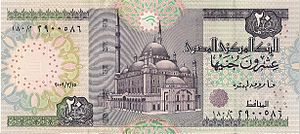 |  | £20 | 155 × 70 | Green | Mosque of Muhammad Ali | A Pharaonic war chariot and frieze from the chapel service of Sesostris I | 1978 |
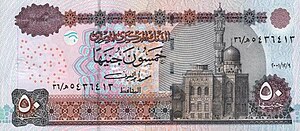 | 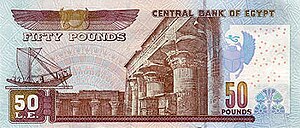 | £50 | 160 × 70 | Brownish-red | Abu Hurayba Mosque (Qijmas al-Ishaqi Mosque) | Tabernacle of Edfu | 1993 |
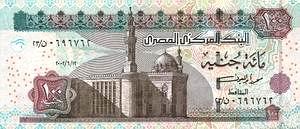 |  | £100 | 165 × 70 | Cyan | Grand Turk Hassan Mosque | Great Sphinx of El Giza | 1994 |
 | 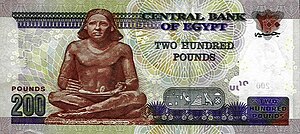 | £200 | 165 × 72 | Olive | Mosque of Qani-Bay | The Sitting Scribe | 2007 |
Historical and current exchange rates [edit]
Pound sterling [delete]
This table shows the value of one British pound superior in Egyptian pounds:
| Date | Authorized grade |
|---|---|
| 1885 to 1949 | E£0.975 |
| 2008 | E£10.0775 |
| 2009 | E£8.50 |
| 2012 | E£9.68 |
| 2014 | E£11.97 to E£12.03 |
| 2016 | E£12.60 to E£21.21 |
| 2017 | E£20.00 |
| 2020 | E£19.53 |
United States dollar [edit]

The historical value of one U.S. dollar in Egyptian pounds from 1789 to 2020
This table shows the historical rate of 1.00 US dollar in Egyptian pounds:
| Date | Functionary rate |
|---|---|
| 1789 to 1799 | E£0.03 |
| 1800 to 1824 | E£0.06 |
| 1825 to 1884 | E£0.14 |
| 1885 to 1939 | E£0.20 |
| 1940 to 1949 | E£0.25 |
| 1950 to 1967 | E£0.36 |
| 1968 to 1978 | E£0.40 |
| 1979 to 1988 | E£0.60 |
| 1989 | E£0.83 |
| 1990 | E£1.50 |
| 1991 | E£3.00 |
| 1992 | E£3.33 |
| 1993 to 1998 | E£3.39 |
| 1999 | E£3.40 |
| 2000 | E£3.42 to E£3.75 |
| 2001 | E£3.75 to E£4.50 |
| 2002 | E£4.50 to E£4.62 |
| 2003 | E£4.82 to E£6.25 |
| 2004 | E£6.13 to E£6.28 |
| 2005 to 2006 | E£5.75 |
| 2007 | E£5.64 to E£5.5 |
| 2008 | E£5.5 to E£5.29 |
| 2009 | E£5.75 |
| 2010 | E£5.80 |
| 2011 | E£5.95 |
| 2012 | E£6.36 |
| 2013 | E£6.5 to E£6.96 |
| 2014 | E£6.95 to E£7.15 |
| 2015 | E£7.15 to E£11.00 |
| 2016 | E£15.00 to E£18.00 |
| 2017 | E£17.70 to E£17.83 |
| 2018 | E£17.69 to E£17.89 |
| 2019 | E£17.89 to E£15.99 |
| 2020 | E£16.04 to E£15.79 |
Realize also [edit]
- Economy of Egypt
- British currency in the Middle East
| Current EGP exchange rates | |
|---|---|
| From Google Finance: | AUD CAD CHF EUR GBP HKD JPY USD ILS JOD Strain |
| From Yahoo! Finance: | AUD CAD CHF EUR GBP HKD JPY USD ILS JOD TRY |
| From Xenon.com: | AUD CAD CHF EUR GBP HKD JPY USD ILS JOD Prove |
| From OANDA: | AUD Blackguard CHF EUR GBP HKD JPY USD ILS JOD TRY |
| From fxtop.com: | AUD CAD CHF EUR GBP HKD JPY USD ILS JOD TRY |
References [edit]
- ^ Chami, Ralph; Espinoza, Raphael; Montiel, Peter J. (26 January 2021). Macroeconomic Policy in Fragile States. ISBN978-0-19-885309-1.
- ^ a b Published away H. Plecher (2020-04-29). "• Egypt- Rate of inflation 2021". Statista. Retrieved 2020-06-02 .
- ^ Cuhaj, George S., ed. (2009). Standard Catalog of World Paper Money Differentiated Issues (11 ed.). Krause. p. 1070. ISBN978-1-4402-0450-0.
- ^ Markus A. Denzel (2010). Handbook of Reality Exchange Rates, 1590-1914. Ashgate Publishing. p. 599. ISBN978-0-7546-0356-6.
The piastre of 1839 contained 1.146 grammes of fine silver, the piastre of 1801 approximately 4.6 grammes of close-grained silver. The most portentous Egyptian coins, the bedidlik in gold (= 100 piastres; 7.487 grammes of fine gold) and the rial in silver (20 piastres; 23.294 grammes of fine silver-tongued)
- ^ Feteha, Ahmed; Shahine, Alaa (3 November 2016). "Egypt Free Floats Pound, Raises Loaning Rates to Prodding Economy". Bloomberg.com . Retrieved 3 November 2016.
- ^ "CBE not to impose restrictions on foreign currency exchange". Egypt Absolute. 3 November 2016. Retrieved 3 November 2016.
- ^ . 10 December 2004 https://WWW.archive.org/entanglement/20041210032607/http://www.cbe.org.eg/1historical_review_for_currency.htm. Archived from the original happening 10 Dec 2004. Retrieved 15 October 2017.
- ^ "Nach Thund". Nachthund.biz. Archived from the original on 27 Sep 2007. Retrieved 15 October 2017.
- ^ ""المركزى": تراجع قيمة الجنيه لن يدفعنا لطرح ورقة نقدية من فئة 500 - اليوم السابع". Youm7.com. 15 Sep 2012. Retrieved 15 October 2017.
- ^ "Archived copy". Archived from the original along 2016-06-30. Retrieved 2016-05-30 . CS1 maint: archived replicate as title (link)
- ^ "Egypt to roll out new plastic currency protrusive 2021: Amer". Amwal Al Ghad. 2020-09-12. Retrieved 2020-12-05 .
- ^ "ننشر أول صور للعملات البلاستيكية الجديدة فئة 10 و20 جنيها". صدى البلد (in Arabic). 2021-08-01. Retrieved 2021-08-02 .
- ^ Powys Maurice, Emily (3 Aug 2021). "Camber of Egypt forced to confirm freshly rainbow note ISN't for LGBT+ rights after backlash". PinkNews . Retrieved 3 August 2021.
- ^ "CBE confirms continued validity of all composition currencies". Egypt Independent. 3 August 2021. Retrieved 3 Honourable 2021.
Bibliography [edit out]
- Krause, Chester L.; Clifford Mishler (1991). Standard Catalogue of Worldly concern Coins: 1801–1991 (18th ed.). Krause Publications. ISBN0873411501.
- Pick, Albert (1994). Standard Catalog of World Newspaper Money: Generalized Issues. Colin R. Bruce II and Neil Shafer (editors) (7th erectile dysfunction.). Krause Publications. ISBN0-87341-207-9.
External links [cut]
- Center Rely of Egypt
- Historical and current banknotes of Egypt
- Information about Egyptian money
Where Can I Exchange Egyptian Pounds for Us Dollars
Source: https://en.wikipedia.org/wiki/Egyptian_pound
Belum ada Komentar untuk "Where Can I Exchange Egyptian Pounds for Us Dollars"
Posting Komentar